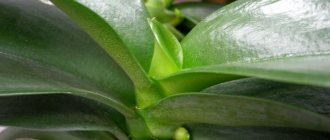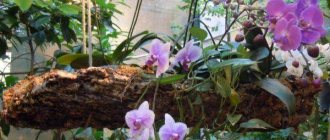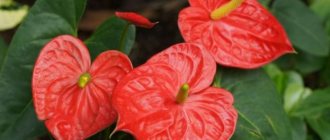I want to admire the luxurious orchid flowers endlessly. These are real royal soloists who look rather inconspicuous outside the flowering period. The time when soaring flowers open one after another and gradually reach the peak of decorativeness, you really want to prolong it longer. There is only one way to increase the flowering time of any orchid - to provide it with the right conditions and careful care.
Phalaenopsis orchids in flowerpots
Extending the flowering time of an orchid, increasing the period during which the plant pleases with its flowers, is a task as difficult as stimulating or controlling the flowering of orchids in general. Achieving the appearance of buds and then their blossoming is possible only with proper care.
At the slightest deviation in conditions or an error in watering, even the most hardy and unpretentious of orchids can surprise with unpleasant manifestations. Falling buds, drying out of buds and even peduncles, opening of flowers for only a few days, rapid opening of all buds and the same rapid flowering - these are just a few of the troubles awaiting fans of indoor orchids.
Regulating the duration of flowering is one of the most important means of controlling the flowering process of all orchids. The formation of buds and the flowering itself directly depend on the care conditions, changes in which can be used to prolong the pleasure for the maximum period.
There are two main factors that allow you to control the flowering time of any orchid:
- air temperature in two values – night and day indicators;
- length of daylight hours.
They “manage” the duration of the orchid’s flowering in the same way as when controlling the timing of flowering. Increasing the length of daylight hours and controlling temperatures at night allows not only to stimulate and delay flowering until the desired date, to stop or begin the development of buds in the sheath, but even to accelerate or slow down their blooming.
But all other components of orchid care also influence the duration of flowering. It is possible to ensure that plants bloom for a long time and surprise with the persistence of flowers only with sufficient diligence and careful monitoring of all possible parameters of growing conditions.
The process of controlling the duration of flowering and artificially extending it can begin from the moment the buds appear in their sheaths and can be continued until the last flower in the inflorescences blooms.
Cattleya orchid
The problem of shortened or incomplete flowering can arise with any orchid - both hybrids and luxurious species plants. Usually, a special increase in the duration of flowering is talked about in relation to phalaenopsis, but all orchids can be “made” to bloom more beautifully and longer if the right conditions are created for them. If all recommendations for the flowering period are followed, phalaenopsis and vandas can bloom literally throughout almost the entire year, and other orchids - from 2 to 6 months. Any shorter flowering period indicates problems with conditions or care.
Life cycle
First, the orchid actively grows green mass and root system. To enter the flowering stage, it needs a full rosette of 5-8 strong leaves . It takes from 1.5 to 3 years to form and strengthen the roots.
The flowering period lasts from 3 to 10 months. At this point, foliage and root growth slows down. It will resume after the plant has flowered and remains dormant for 2-3 months. Then the formation of new flower stalks will begin.
Make a decoction of onion peels
Onion peels contain a huge amount of a wide variety of mineral and biologically active substances that are vital for orchids. For example, phytoncides, mineral salts, carotene, as well as vitamins of groups C, B, E and PP. In addition to the disinfecting effect, this combination of beneficial substances helps nourish the roots of plants and their tone. Onion peels are rich in quercetin, which has an extremely beneficial effect on orchids. Especially a lot of this element is contained in the bulbs of red varieties. The husk can strengthen the plant's immunity, enhance growth and repel pests. It can be added to the soil or prepared as an infusion for spraying.
Place a handful of husks in an enamel bowl and pour boiling water (about 1.5 liters). Boil for another 5-7 minutes, let it brew (2 hours will be enough), and then strain. The remaining husks after straining can be used as compost if desired.
Experienced flower growers are convinced that it is enough to prepare such fertilizer once a month and spray it on plants and the soil surface for preventive disinfection. But keep in mind that each time this useful remedy will have to be prepared anew, since the infusion cannot be stored.
What is needed for flowers to appear?
For normal development and growth of the orchid, it is necessary to maintain an appropriate microclimate in the room. The plant will bloom profusely if you adhere to the following recommendations :
- Use only transparent containers for growing phalaenopsis. Its root system also takes part in photosynthesis, so they need constant access to light.
- Do not plant the flower in pots with embossed walls or sharp corners, otherwise the roots will grow to the uneven surface or may be injured.
- Choose a permanent place for the container with the orchid and do not move it even during watering. Moving causes stress and slows down metabolic processes.
- Provide sufficient lighting. The duration of daylight should be at least 10-12 hours. In the cold season, its deficiency is compensated for by phytolamps, which provide bright light, but do not dry out the air near the flower and do not overheat it.
- Maintain humidity levels between 60-70%. If the room is too dry, place a glass of water near the pot or spray the leaves with a spray bottle.
Reference . When bred at home, phalaenopsis blooms mainly in the cold season. Its flowering period lasts from November to March-April.
Reasons for absence
Healthy orchids do not produce flower stalks for several reasons.:
- they have not yet reached adulthood;
- the indoor microclimate is too comfortable - without a difference in night and day temperatures, as in nature;
- lacks nutrients.
Knowing what exactly prevents flowering, you can easily correct the situation. Sometimes it’s enough just to wait for the plant to grow or feed it.
Differences between home and nature
The life cycle of an orchid remains unchanged even when grown at home . It is divided into 3 stages:
- height;
- bloom;
- peace.
The only difference is that in its natural habitat the plant blooms longer , and the flowers themselves are larger and brighter. In nature, phalaenopsis has constant access to the required amount of nutrients, and the level of humidity and light fully corresponds to its needs.
Step-by-step instructions for stimulation
If the orchid has reached the age of 2-3 years, but does not bloom, artificial stimulation will be needed. But this method can only be used for healthy plants with a strong root system and powerful leaves.
How to make it produce buds?
You need to create a stressful situation for the flower. To do this you need:
- Take 10 liters of water and wait for it to settle for 24 hours. Then the leaves and roots will not suffer from high concentrations of chlorine.
- Heat the settled water to 40-45 degrees.
- Place the orchid pot in it for half an hour.
Attention! The water should be warm enough and tolerable for the skin of your hands, but not hot so as not to burn the plant.
After the procedure, the container with phalaenopsis is placed in its original place.
Video on how to make an orchid bloom:
How to extend the process?
You can increase the duration of flowering by adjusting the lighting mode . This is done as follows:
- In winter, a phytolamp is installed above the orchid pot. The light should be diffused, not intense.
- Additional light is turned on in the evening to extend daylight hours to 12 hours.
- After the buds bloom, the duration of daylight hours is reduced to 10-11 hours.
- And if the plant produces a peduncle in the summer, the window is shaded so that the direct rays of the sun do not fall on it. As a result, the lifespan of each flower increases by 3-4 days.
Video on how to prolong the flowering of an orchid:
How to care?
At each stage of development, the orchid requires certain attention. During the period of active formation of flower stalks, it needs watering and additional nutrition . And after flowering, the plant is prepared for the resting phase and sanitized. And if everything is done correctly, after a few months the flower will again delight you with blooming buds.
During the period when the plant blooms
During this period, phalaenopsis needs the following activities:
- Regular moisturizing . At the stage of peduncle formation, the interval between waterings is reduced, otherwise the buds will quickly fall off due to lack of moisture. But you also can’t over-water the soil; it must dry out completely before the next irrigation. For irrigation, use only warm and settled water.
- Fertilizer application . Fertilizers are selected on a potassium and phosphorus basis, with a low nitrogen concentration. This will speed up the formation of buds and extend the flowering period.
- Additional fixation . If you want to get an erect peduncle with a cascade of flowers, you need to use a vertical support even at the stage of its growth.
- Protection from drafts and maintaining humidity at a level of at least 60% . To do this, place a small reservoir of water next to the pot or gently spray the leaves with a spray bottle.
- Artificial lighting to extend daylight up to 12 hours . Will be needed during the cold season or cloudy weather.
Important! After the buds open, the orchid should not be disturbed. This applies to both her place of stay and changes in her conditions of detention. At this time, only the frequency of watering is changed.
Aftercare
As soon as the last bud falls, the flower needs to be prepared to enter the dormant stage . To do this you need:
- Inspect the condition of the roots. A healthy root system has a gray or green tint. If there are dry or rotten roots, carefully trim them with scissors. Immediately sprinkle the cut areas with ash.
- Sanitize the leaves and stem. Remove areas with stains and rot. This will help avoid complete infection of the plant.
- Reduce the room temperature by 2-3 degrees.
- Reduce the frequency of watering and stop fertilizing.
The resting phase of an orchid lasts from 3 weeks to 3 months . At this time, she restores her strength for the next flowering.
A few more tips
Remember to provide the flower arrow with adequate support. The best support for the peduncle will be flexible and durable hibiscus stems; they will allow you to guide the peduncle and ensure the balance of the orchid.
Mist your orchid regularly. Moreover, it is better to carry out the procedure by treating the back sides of the leaves. This treatment will keep the growing point dry.
Do not try to immediately transplant the orchid into a new pot. If the flower shoots out an arrow, the design of the pot should fade into the background, and the replanting should be postponed indefinitely. Let the orchid bloom quietly and only after flowering is over, transfer it to a new home.
Found a violation? Report content
Possible problems
If the phalaenopsis does not have enough light or moisture at this time, this leads to the following consequences:
- drying of flower ovaries;
- reducing flowering time;
- rapid fall of flowers.
But direct sunlight is also harmful to a blooming orchid. They can cause burns. If the pot is on the south side of the house, the window is slightly shaded.
also reacts sharply to extreme heat . To avoid exposing it to heat stroke, the room must be periodically ventilated, but avoid drafts. Otherwise, the leaves will lose their elasticity and begin to wither, followed by the interruption of the flowering process.
Daily temperature changes are also important for a flower. The difference between the indicators should be within 4-7 degrees. If the temperature is the same day and night, the buds will wither faster. Best option:
- during the day, maintain the air temperature at +25-27 degrees;
- and at night – from +18 to +20.
A lushly blooming orchid is the result of proper care and careful treatment of it. If you create a suitable microclimate for phalaenopsis indoors and use additional stimulation methods, it will bloom from 3 to 10 months. And in order to achieve repeated flowering, you need to give the flower the opportunity to restore its strength during the dormant period.
LiveInternetLiveInternet
–Categories
- Recipes (6903)
- Knitting (4980)
- Health (2308)
- Self-Care (1768)
- Sewing (1112)
- Just interesting and useful (1004)
- Crafts (974)
- Diets (926)
- Sports exercises (590)
- Embroidery (479)
- Housekeeping (415)
- Needlework. Costume jewelry (326)
- Photos (315)
- Handicrafts (307)
- Canning (303)
- Travel (293)
- Parenting (285)
- Me and COMP (284)
- Hair (275)
- Beading (260)
- Psychology (245)
- Drinks (238)
- Clothes in our lives (232)
- Wise thoughts (231)
- Let's improve our life (207)
- Interior design (198)
- Plants in the house (197)
- Massage (192)
- Study (190)
- Magic (187)
- Rejuvenation (180)
- Garden. Vegetable garden (165)
- Bags (152)
- Curtains (136)
- We lure money (124)
- Scrapbooking (115)
- Drawing (112)
- English (103)
- Handmade (102)
- PRAYERS (98)
- Embroidery (94)
- yoga (85)
- Painting (81)
- Photoshop (76)
- Multicooker (68)
- Animals and birds (68)
- Manicure (62)
- Dancing (61)
- Conspiracies (57)
- Makeup (56)
- Music (54)
- Funny but true (45)
- Books (35)
- Art (34)
- Repair (34)
- Wedding (34)
- Essential oils (33)
- Mudra and Aura (31)
- Zodiac Signs (30)
- PRAYERS - GUARDS (26)
- Perfume (25)
- Museums (24)
- Countries of the world (24)
- Birthday (23)
- Gold. Silver. Stones (21)
- Felting (20)
- For motorists (20)
- Sushi Rolls (19)
- Macrame (18)
- Feng Shui (16)
- Accessories (15)
- Fortune telling (15)
- Me and the phone (14)
- Speech therapy. Diction (12)
- Movies. Cinema (11)
- Tongue twisters (11)
- Modeling (10)
- Etiquette (10)
- Care of clothes and shoes (8)
- Bouquets (8)
- Electronic library (7)
- Theater (7)
- School subjects (7)
- Art (5)
- Boho (5)
- Meditation (4)
- Logic (4)
- History (3)
- Holidays abroad (3)
- Italian (2)
- Practices (1)
- Floristry (1)
- Scammers (1)
- Encyclopedia (1)
- Essential oils (1)
- Scammers (0)
- Movies. Cinema (0)
- Perfume (0)
- Fortune telling (0)
- Hairstyles (0)
- Hairstyles (0)











